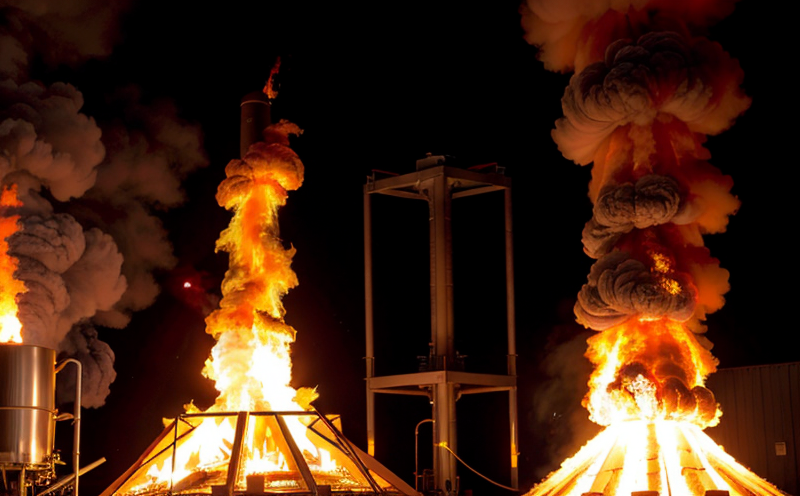Ink Flammability Testing
Flammability testing of ink is a critical step in ensuring product safety and compliance with industry standards. This test assesses the likelihood that an ink will ignite and burn under specified conditions, which is particularly important for consumer products like paints, coatings, and printing inks. The primary goal is to evaluate the safety risks associated with accidental ignition during manufacturing, storage, or use.
Ink flammability testing plays a vital role across various industries, including automotive, aerospace, construction, and packaging. In these sectors, compliance with regulations such as ASTM D1979-23 and ISO 8685 is essential to prevent fires that could lead to property damage or personal injury.
The testing process involves exposing ink samples to specific environmental conditions designed to simulate real-world scenarios where flammability might occur. The apparatus used includes a flame tester capable of delivering controlled flame exposure, ensuring consistent and reproducible results. Specimen preparation typically requires the ink to be applied uniformly on a non-flammable substrate.
The methodology follows standardized procedures that dictate the duration and intensity of the flame exposure. After the test, the sample is observed for any signs of ignition or continued burning. The outcome determines whether the ink meets industry safety standards.
Compliance with these tests can significantly reduce the risk of accidents and enhance consumer trust in products. For instance, in the automotive industry, flammability testing ensures that paints used on vehicles do not pose a fire hazard during transportation or use. Similarly, in packaging, ensuring ink does not ignite under typical conditions is crucial for maintaining safety standards.
The importance of this service extends beyond mere compliance; it also helps companies differentiate their products in the market by demonstrating superior quality and reliability. By investing in robust flammability testing, businesses can build a reputation as leaders in product safety and innovation.
Scope and Methodology
The scope of ink flammability testing encompasses the evaluation of how easily an ink sample ignites and burns under controlled conditions. This service utilizes ASTM D1979-23 or ISO 8685 as reference standards, ensuring consistency and accuracy in the testing process.
During the test, a standardized flame is applied to the ink-saturated specimen for a specified duration. The apparatus used includes a specially designed flame tester that delivers controlled exposure to the ink sample. The duration of exposure varies depending on the specific standard being followed but typically ranges from 5 seconds to several minutes.
The specimen preparation involves applying the ink uniformly onto a non-flammable substrate, ensuring that only the ink itself is exposed to the flame. This step is crucial for obtaining accurate and reliable results. After exposure, the sample is observed for any signs of ignition or continued burning. The apparatus used in this process includes:
- Flame tester
- Non-flammable substrate
- Spectrometer (for measuring flame properties)
- Data recording equipment
The results of the test are analyzed to determine whether the ink meets the specified criteria. Compliance with these tests ensures that products do not pose a fire hazard, thereby enhancing safety and consumer trust.
Benefits
Ink flammability testing offers numerous benefits for manufacturers and end-users alike. By conducting this test, companies can ensure their products meet the stringent requirements set by industry standards like ASTM D1979-23 or ISO 8685.
One of the primary advantages is enhanced safety. Flammability testing helps identify potential risks associated with ink exposure during manufacturing, storage, and use. This ensures that products do not ignite easily under typical conditions, reducing the likelihood of accidental fires. Compliance with these standards can also mitigate legal liabilities and insurance costs.
Another significant benefit is improved product quality. By adhering to stringent testing protocols, manufacturers can identify and address any inconsistencies in their ink formulations. This leads to more consistent and reliable products that meet customer expectations.
Ink flammability testing also facilitates market differentiation. In a competitive marketplace, demonstrating compliance with industry standards can set a product apart from competitors. This can lead to increased market share and customer loyalty.
Use Cases and Application Examples
| Industry Sector | Product Type | Testing Criteria |
|---|---|---|
| Aerospace | Coatings | ASTM D1979-23 |
| Automotive | Paints | ISO 8685 |
| Construction | Certified paints | ASTM D1979-23 |
| Packaging | Inks for food packaging | ISO 8685 |
| Furniture | Finishes | ASTM D1979-23 |
Ink flammability testing is particularly relevant in the construction industry, where fire safety is a critical concern. For instance, paints used in buildings must not ignite easily under typical conditions to prevent accidental fires that could lead to property damage or personal injury.
The automotive sector also benefits significantly from this service. Paints applied to vehicles must comply with stringent testing protocols to ensure they do not catch fire during transportation or use. This reduces the risk of accidents and enhances consumer trust in the product.
In packaging, ensuring that inks used on food containers do not ignite under typical conditions is crucial for maintaining safety standards. Flammability testing helps manufacturers identify any potential risks associated with ink exposure and take necessary precautions to mitigate them.





